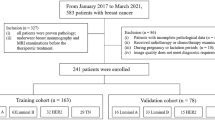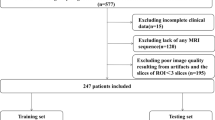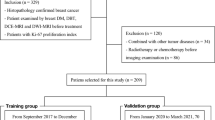Abstract
Objectives
To develop and validate radiomic models for preoperative prediction of intraductal component in invasive breast cancer (IBC-IC) using the intratumoral and peritumoral features derived from dynamic contrast-enhanced MRI (DCE-MRI).
Methods
The prediction models were developed in a primary cohort of 183 consecutive patients from September 2017 to December 2018, consisting of 45 IBC-IC and 138 invasive breast cancers (IBC). The validation cohort of 111 patients (27 IBC-IC and 84 IBC) from February 2019 to January 2020 was enrolled to test the prediction models. A total of 208 radiomic features were extracted from the intratumoral and peritumoral regions of MRI-visible tumors. Then the radiomic features were selected and combined with clinical characteristics to construct predicting models using the least absolute shrinkage and selection operator. The area under the curve (AUC) of receiver operating characteristic, sensitivity, and specificity were used to evaluate the performance of radiomic models.
Results
Four radiomic models for prediction of IBC-IC were built including intratumoral radiomic signature, peritumoral radiomic signature, peritumoral radiomic nomogram, and combined intratumoral and peritumoral radiomic signature. The combined intratumoral and peritumoral radiomic signature had the optimal diagnostic performance, with the AUC, sensitivity, and specificity of 0.821 (0.758–0.874), 0.822 (0.680–0.920), and 0.739 (0.658–0.810) in the primary cohort and 0.815 (0.730–0.882), 0.778 (0.577–0.914), and 0.738 (0.631–0.828) in the validation cohort.
Conclusions
The radiomic model based on the combined intratumoral and peritumoral features from DCE-MRI showed a good ability to preoperatively predict IBC-IC, which might facilitate the individualized surgical planning for patients with breast cancer before breast-conserving surgery.
Key Points
•·Preoperative prediction of intraductal component in invasive breast cancer is crucial for breast-conserving surgery planning.
• Peritumoral radiomic features of invasive breast cancer contain useful information to predict intraductal components.
•·Radiomics is a promising non-invasive method to facilitate individualized surgical planning for patients with breast cancer before breast-conserving surgery.




Similar content being viewed by others
Abbreviations
- ACR BI-RADS:
-
American College of Radiology Breast Imaging Reporting and Data System
- AUC:
-
Area under the curve
- BCS:
-
Breast-conserving surgery
- CI:
-
Confidence interval
- DCE-MRI:
-
Dynamic contrast-enhanced MRI
- DCIS:
-
Ductal carcinoma in situ
- ER:
-
Estrogen receptor
- ETL:
-
Echo train length
- FOV:
-
Field of view
- HER2:
-
Human epidermal growth factor receptor 2
- IBC:
-
Invasive breast cancer
- IBC-IC:
-
Intraductal component in invasive breast cancer
- IBSI:
-
Image biomarker standardization initiative
- ICC:
-
Intraclass correlation coefficient
- LASSO:
-
Least absolute shrinkage and selection operator
- NEX:
-
Number of excitations
- NME:
-
Non-mass enhancement
- ROC:
-
Receiver operating characteristic
- ROI:
-
Region of interest
- PR:
-
Progesterone receptor
- TA:
-
Total acquisition time
- TE:
-
Echo time
- TR:
-
Repetition time
- TRIPOD:
-
Transparent reporting of a multivariable prediction model for individual prognosis or diagnosis statement
References
Siegel RL, Miller KD, Fuchs HE, Jemal A (2021) Cancer Statistics, 2021. CA Cancer J Clin 71:7–33
Sung H, Ferlay J, Siegel RL et al (2021) Global cancer statistics 2020: GLOBOCAN estimates of incidence and mortality worldwide for 36 cancers in 185 countries. CA Cancer J Clin. https://doi.org/10.3322/caac.21660
Sjöström M, Chang SL, Fishbane N et al (2019) Clinicogenomic radiotherapy classifier predicting the need for intensified locoregional treatment after breast-conserving surgery for early-stage breast cancer. J Clin Oncol 37:3340–3349
van Maaren MC, de Munck L, de Bock GH et al (2016) 10 year survival after breast-conserving surgery plus radiotherapy compared with mastectomy in early breast cancer in the Netherlands: a population-based study. Lancet Oncol 17:1158–1170
Marinovich ML, Azizi L, Macaskill P et al (2016) The association of surgical margins and local recurrence in women with ductal carcinoma in situ treated with breast-conserving therapy: a meta-analysis. Ann Surg Oncol 23:3811–3821
Houssami N, Macaskill P, Marinovich ML, Morrow M (2014) The association of surgical margins and local recurrence in women with early-stage invasive breast cancer treated with breast-conserving therapy: a meta-analysis. Ann Surg Oncol 21:717–730
Voogd AC, Nielsen M, Peterse JL et al (2001) Differences in risk factors for local and distant recurrence after breast-conserving therapy or mastectomy for stage I and II breast cancer: pooled results of two large European randomized trials. J Clin Oncol 19:1688–1697
Nayyar A, Gallagher KK, McGuire KP (2018) Definition and management of positive margins for invasive breast cancer. Surg Clin North Am 98:761–771
van Deurzen CH (2016) Predictors of surgical margin following breast-conserving surgery: a large population-based cohort study. Ann Surg Oncol 23:627–633
Bae MS, Bernard-Davila B, Sung JS, Morris EA (2019) Preoperative breast MRI features associated with positive or close margins in breast-conserving surgery. Eur J Radiol 117:171–177
Kang JH, Youk JH, Kim JA et al (2018) Identification of preoperative magnetic resonance imaging features associated with positive resection margins in breast cancer: a retrospective study. Korean J Radiol 19:897–904
Houvenaeghel G, Lambaudie E, Bannier M et al (2019) Positive or close margins: reoperation rate and second conservative resection or total mastectomy? Cancer Manag Res 11:2507–2516
Jeevan R, Cromwell DA, Trivella M et al (2012) Reoperation rates after breast conserving surgery for breast cancer among women in England: retrospective study of hospital episode statistics. BMJ 345:e4505
Schnitt SJ, Harris JR (2008) Evolution of breast-conserving therapy for localized breast cancer. J Clin Oncol 26:1395–1396
Kuhl CK, Lehman C, Bedrosian I (2020) Imaging in locoregional management of breast cancer. J Clin Oncol 38:2351–2361
Berg WA, Gutierrez L, NessAiver MS et al (2004) Diagnostic accuracy of mammography, clinical examination, US, and MR imaging in preoperative assessment of breast cancer. Radiology 233:830–849
Kuhl CK, Schrading S, Bieling HB et al (2007) MRI for diagnosis of pure ductal carcinoma in situ: a prospective observational study. Lancet 370:485–492
Yoon GY, Choi WJ, Kim HH, Cha JH, Shin HJ, Chae EY (2020) Surgical outcomes for ductal carcinoma in situ: impact of preoperative MRI. Radiology 295:296–303
Gommers JJJ, Duijm LEM, Bult P et al (2021) The impact of preoperative breast MRI on surgical margin status in breast cancer patients recalled at biennial screening mammography: an observational cohort study. Ann Surg Oncol. https://doi.org/10.1245/s10434-021-09868-1
Knuttel FM, van der Velden BH, Loo CE et al (2016) Prediction model for extensive ductal carcinoma in situ around early-stage invasive breast cancer. Invest Radiol 51:462–468
Kuhl CK, Strobel K, Bieling H et al (2017) Impact of preoperative breast MR imaging and MR-guided surgery on diagnosis and surgical outcome of women with invasive breast cancer with and without DCIS component. Radiology 284:645–655
Van Goethem M, Schelfout K, Kersschot E et al (2007) MR mammography is useful in the preoperative locoregional staging of breast carcinomas with extensive intraductal component. Eur J Radiol 62:273–282
Gillies RJ, Kinahan PE, Hricak H (2016) Radiomics: images are more than pictures, they are data. Radiology 278:563–577
Bi WL, Hosny A, Schabath MB et al (2019) Artificial intelligence in cancer imaging: clinical challenges and applications. CA Cancer J Clin 5:21552
Li Z, Ai T, Hu Y et al (2018) Application of whole-lesion histogram analysis of pharmacokinetic parameters in dynamic contrast-enhanced MRI of breast lesions with the CAIPIRINHA-Dixon-TWIST-VIBE technique. J Magn Reson Imaging 47:91–96
Dijkstra H, Dorrius MD, Wielema M, Pijnappel RM, Oudkerk M, Sijens PE (2016) Quantitative DWI implemented after DCE-MRI yields increased specificity for BI-RADS 3 and 4 breast lesions. J Magn Reson Imaging 44:1642–1649
**e T, Zhao Q, Fu C et al (2018) Differentiation of triple-negative breast cancer from other subtypes through whole-tumor histogram analysis on multiparametric MR imaging. Eur Radiol 6:018–5804
Drisis S, Metens T, Ignatiadis M, Stathopoulos K, Chao SL, Lemort M (2016) Quantitative DCE-MRI for prediction of pathological complete response following neoadjuvant treatment for locally advanced breast cancer: the impact of breast cancer subtypes on the diagnostic accuracy. Eur Radiol 26:1474–1484
Braman NM, Etesami M, Prasanna P et al (2017) Intratumoral and peritumoral radiomics for the pretreatment prediction of pathological complete response to neoadjuvant chemotherapy based on breast DCE-MRI. Breast Cancer Res 19:017–0846
Wu J, Gong G, Cui Y, Li R (2016) Intratumor partitioning and texture analysis of dynamic contrast-enhanced (DCE)-MRI identifies relevant tumor subregions to predict pathological response of breast cancer to neoadjuvant chemotherapy. J Magn Reson Imaging 44:1107–1115
Kim JY, Kim SH, Kim YJ et al (2015) Enhancement parameters on dynamic contrast enhanced breast MRI: do they correlate with prognostic factors and subtypes of breast cancers? Magn Reson Imaging 33:72–80
Pickles MD, Lowry M, Gibbs P (2016) Pretreatment prognostic value of dynamic contrast-enhanced magnetic resonance imaging vascular, texture, shape, and size parameters compared with traditional survival indicators obtained from locally advanced breast cancer patients. Invest Radiol 51:177–185
Chang RF, Chen HH, Chang YC, Huang CS, Chen JH, Lo CM (2016) Quantification of breast tumor heterogeneity for ER status, HER2 status, and TN molecular subtype evaluation on DCE-MRI. Magn Reson Imaging 34:809–819
Li H, Zhu Y, Burnside ES et al (2016) MR imaging radiomics signatures for predicting the risk of breast cancer recurrence as given by research versions of MammaPrint, Oncotype DX, and PAM50 gene assays. Radiology 281:382–391
Park H, Lim Y, Ko ES et al (2018) Radiomics signature on magnetic resonance imaging: association with disease-free survival in patients with invasive breast cancer. Clin Cancer Res 24:4705–4714
Pinker K, Chin J, Melsaether AN, Morris EA, Moy L (2018) Precision medicine and radiogenomics in breast cancer: new approaches toward diagnosis and treatment. Radiology 287:732–747
Schuh F, Biazús JV, Resetkova E et al (2015) Histopathological grading of breast ductal carcinoma in situ: validation of a web-based survey through intra-observer reproducibility analysis. Diagn Pathol 10:93
Goldhirsch A, Winer EP, Coates AS et al (2013) Personalizing the treatment of women with early breast cancer: highlights of the St Gallen International Expert Consensus on the Primary Therapy of Early Breast Cancer 2013. Ann Oncol 24:2206–2223
Luo HB, Du MY, Liu YY et al (2020) Differentiation between luminal a and b molecular subtypes of breast cancer using pharmacokinetic quantitative parameters with histogram and texture features on preoperative dynamic contrast-enhanced magnetic resonance imaging. Acad Radiol 27:e35–e44
Luo HB, Liu YY, Wang CH et al (2021) Radiomic features of axillary lymph nodes based on pharmacokinetic modeling DCE-MRI allow preoperative diagnosis of their metastatic status in breast cancer. PLoS One 16:e0247074
Hao W, Zhao B, Wang G, Wang C, Liu H (2015) Influence of scan duration on the estimation of pharmacokinetic parameters for breast lesions: a study based on CAIPIRINHA-Dixon-TWIST-VIBE technique. Eur Radiol 25:1162–1171
Liu C, Ding J, Spuhler K et al (2019) Preoperative prediction of sentinel lymph node metastasis in breast cancer by radiomic signatures from dynamic contrast-enhanced MRI. J Magn Reson Imaging 49:131–140
Ding J, Chen S, Serrano Sosa M et al (2020) Optimizing the peritumoral region size in radiomics analysis for sentinel lymph node status prediction in breast cancer. Acad Radiol. https://doi.org/10.1016/j.acra.2020.10.015
Li C, Song L, Yin J (2021) Intratumoral and peritumoral radiomics based on functional parametric maps from breast DCE-MRI for prediction of HER-2 and Ki-67 Status. J Magn Reson Imaging. https://doi.org/10.1002/jmri.27651
van Griethuysen JJM, Fedorov A, Parmar C et al (2017) Computational radiomics system to decode the radiographic phenotype. Cancer Res 77:e104–e107
Zwanenburg A, Vallieres M, Abdalah MA et al (2020) The image biomarker standardization initiative: standardized quantitative radiomics for high-throughput image-based phenoty**. Radiology 295:328–338
Carré A, Klausner G, Edjlali M et al (2020) Standardization of brain MR images across machines and protocols: bridging the gap for MRI-based radiomics. Sci Rep 10:12340
Sauerbrei W, Royston P, Binder H (2007) Selection of important variables and determination of functional form for continuous predictors in multivariable model building. Stat Med 26:5512–5528
Steyerberg EW, Vickers AJ, Cook NR et al (2010) Assessing the performance of prediction models: a framework for traditional and novel measures. Epidemiology 21:128–138
Moons KG, Altman DG, Reitsma JB et al (2015) Transparent reporting of a multivariable prediction model for individual prognosis or diagnosis (TRIPOD): explanation and elaboration. Ann Intern Med 162:W1-73
DeLong ER, DeLong DM, Clarke-Pearson DL (1988) Comparing the areas under two or more correlated receiver operating characteristic curves: a nonparametric approach. Biometrics 44:837–845
Hawass NE (1997) Comparing the sensitivities and specificities of two diagnostic procedures performed on the same group of patients. Br J Radiol 70:360–366
Stomper PC, Connolly JL (1992) Mammographic features predicting an extensive intraductal component in early-stage infiltrating ductal carcinoma. AJR Am J Roentgenol 158:269–272
Goh CW, Wu J, Ding S et al (2019) Invasive ductal carcinoma with coexisting ductal carcinoma in situ (IDC/DCIS) versus pure invasive ductal carcinoma (IDC): a comparison of clinicopathological characteristics, molecular subtypes, and clinical outcomes. J Cancer Res Clin Oncol 145:1877–1886
Martin-Dunlap TM, Cyr AE, Al Mushawah F, Gao F, Margenthaler JA (2013) Does the volume of ductal carcinoma in situ impact the positive margin rate in patients undergoing breast conservation for invasive breast cancer? J Surg Res 184:228–233
Chagpar AB, Killelea BK, Tsangaris TN et al (2015) A randomized, controlled trial of cavity shave margins in breast cancer. N Engl J Med 373:503–510
Van Goethem M, Schelfout K, Kersschot E et al (2004) Enhancing area surrounding breast carcinoma on MR mammography: comparison with pathological examination. Eur Radiol 14:1363–1370
Zhou J, Zhang Y, Chang KT et al (2020) Diagnosis of benign and malignant breast lesions on DCE-MRI by using radiomics and deep learning with consideration of peritumor tissue. J Magn Reson Imaging 51:798–809
Braman NM, Etesami M, Prasanna P et al (2017) Intratumoral and peritumoral radiomics for the pretreatment prediction of pathological complete response to neoadjuvant chemotherapy based on breast DCE-MRI. Breast Cancer Res 19:57
Acknowledgements
The authors would like to thank Juan Ji (JJ) and Qiong Liao (QL) for the pathological work and consultation in the study.
Funding
This study has received funding from Sichuan Science and Technology Program (grant numbers 2021YFG0125, 2021YFS0075, and 2021YFS0225).
Author information
Authors and Affiliations
Corresponding authors
Ethics declarations
Guarantor
The scientific guarantor of this publication is Hongbing Luo and **g Ren.
Conflict of interest
The authors of this manuscript declare no relationships with any companies whose products or services may be related to the subject matter of the article.
Statistics and biometry
One of the authors has significant statistical expertise.
Informed consent
The requirement for informed consent was waived and patient data are anonymized.
Ethical approval
Institutional Review Board approval was obtained.
Methodology
• Retrospective
• Diagnostic or prognostic study
• Performed at one institution
Additional information
Publisher's note
Springer Nature remains neutral with regard to jurisdictional claims in published maps and institutional affiliations.
Supplementary Information
Below is the link to the electronic supplementary material.
Rights and permissions
About this article
Cite this article
Xu, H., Liu, J., Chen, Z. et al. Intratumoral and peritumoral radiomics based on dynamic contrast-enhanced MRI for preoperative prediction of intraductal component in invasive breast cancer. Eur Radiol 32, 4845–4856 (2022). https://doi.org/10.1007/s00330-022-08539-3
Received:
Revised:
Accepted:
Published:
Issue Date:
DOI: https://doi.org/10.1007/s00330-022-08539-3




